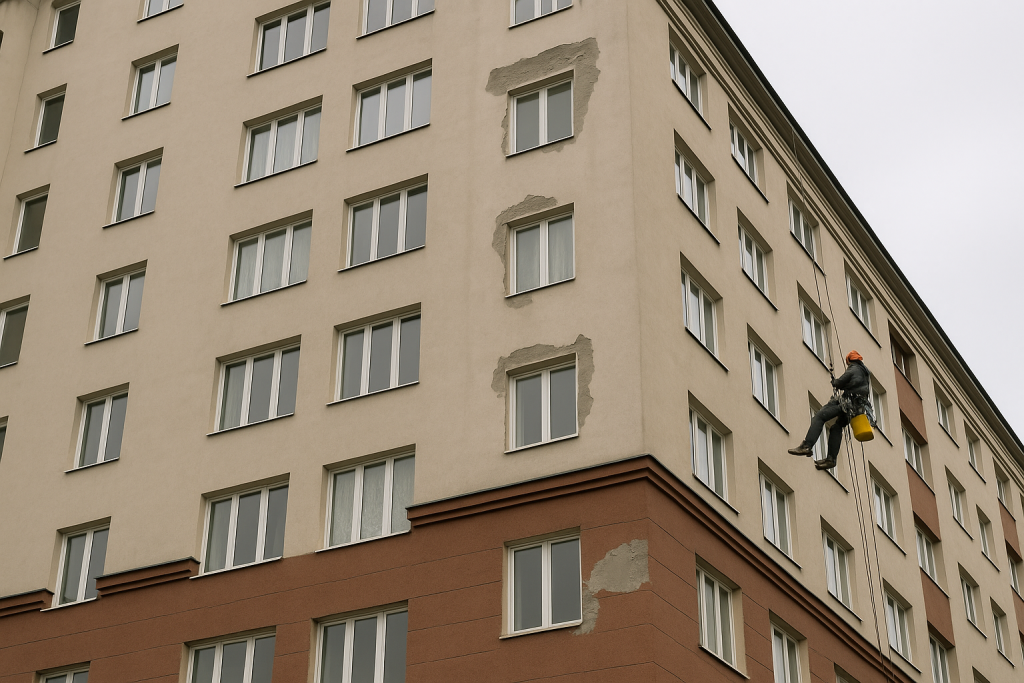Facade inspection after winter: what to check first

After winter, building facades are often damaged by low temperatures, moisture, snow, and wind. This is especially true for buildings that have not undergone regular maintenance. Spring is the perfect time to conduct a facade inspection to identify defects at an early stage and prevent costly repairs in the future.
For a proper inspection, it is important to understand which elements of the facade need attention in the first place.
Main risk areas after winter
The winter period creates several critical factors for facades:
- freezing and expansion of cracks in plaster and cladding;
- moisture accumulation that causes corrosion of metal elements;
- depressurization of inter-panel seams;
- damage to the waterproofing layer or decorative elements.
All this leads to the gradual destruction of the facade and a decrease in the energy efficiency of the building.
What to check first
Experts advise starting a spring checkup with the following elements:
- Condition of the cladding and decorative elements
Plaster, tile, and stone cladding may have visible cracks, chips, or delamination. It is important to detect even small defects, as they can expand over time due to moisture and temperature fluctuations. - Sealing the joints
Inter-panel joints and seams often suffer from temperature changes. Check for:
- cracks or tears in the sealant;
- areas where the sealant has completely lost its elasticity;
- areas with potential leaks.
Timely renewal of the sealant prevents moisture penetration and the formation of fungus inside the walls.
- Metal Elements and Fasteners
Window sills, fascias, gutters, and advertising structures should be inspected for corrosion, deformation, or loose fasteners. Any damage can cause accidents during spring rains or strong winds.
Additional aspects of the inspection
In addition to the main risk areas, there are several important aspects that should not be overlooked during a spring facade inspection. First of all, it is necessary to check the integrity of the insulation under the cladding. Even minor damage to the insulation layer can lead to a loss of energy efficiency of the building, condensation inside the structures and further destruction of the facade. If the insulation gets wet or deformed under the influence of temperature fluctuations, it must be replaced immediately.
An important factor is the absence of waterproofing violations. Violation of the integrity of the protective layer leads to moisture penetration into the walls, which causes the formation of fungus, mold and the gradual destruction of building materials. The areas of joints, slopes, and areas around window and door openings should be checked especially carefully.
It is equally important to assess the condition of decorative elements such as cornices, bas-reliefs, moldings, and other architectural details. Winter can cause microcracks, loosening of fasteners, or partial detachment of finishing materials. The fall of even a small decorative part poses a serious danger to pedestrians and property owners.
You should also pay attention to potential places of water accumulation near the foundation. Spring snowmelt and rains can lead to waterlogging of the soil, which causes additional stress on the foundation and can cause settling or cracks in the walls.
If necessary, it is recommended to involve industrial climbers for a detailed inspection of hard-to-reach areas, especially at height. The use of special equipment allows you to identify hidden defects and carry out preventive maintenance without dismantling large parts of the cladding.
Why regular facade inspection is important
Timely detection of damage not only avoids costly overhauls, but also extends the life of the facade. Even minor cracks can lead to serious problems if ignored. In addition, a well-maintained facade has a positive impact on the aesthetic appearance of the building and its market value.
A professional inspection makes it possible to draw up a clear plan for further work, prioritize repairs, and rationally allocate the budget for facility maintenance.
Interesting articles:
Welding at height for the restoration and repair of metal structures: techniques and methods
Removing hazardous trees in dense urban areas: how to avoid damaging utilities
